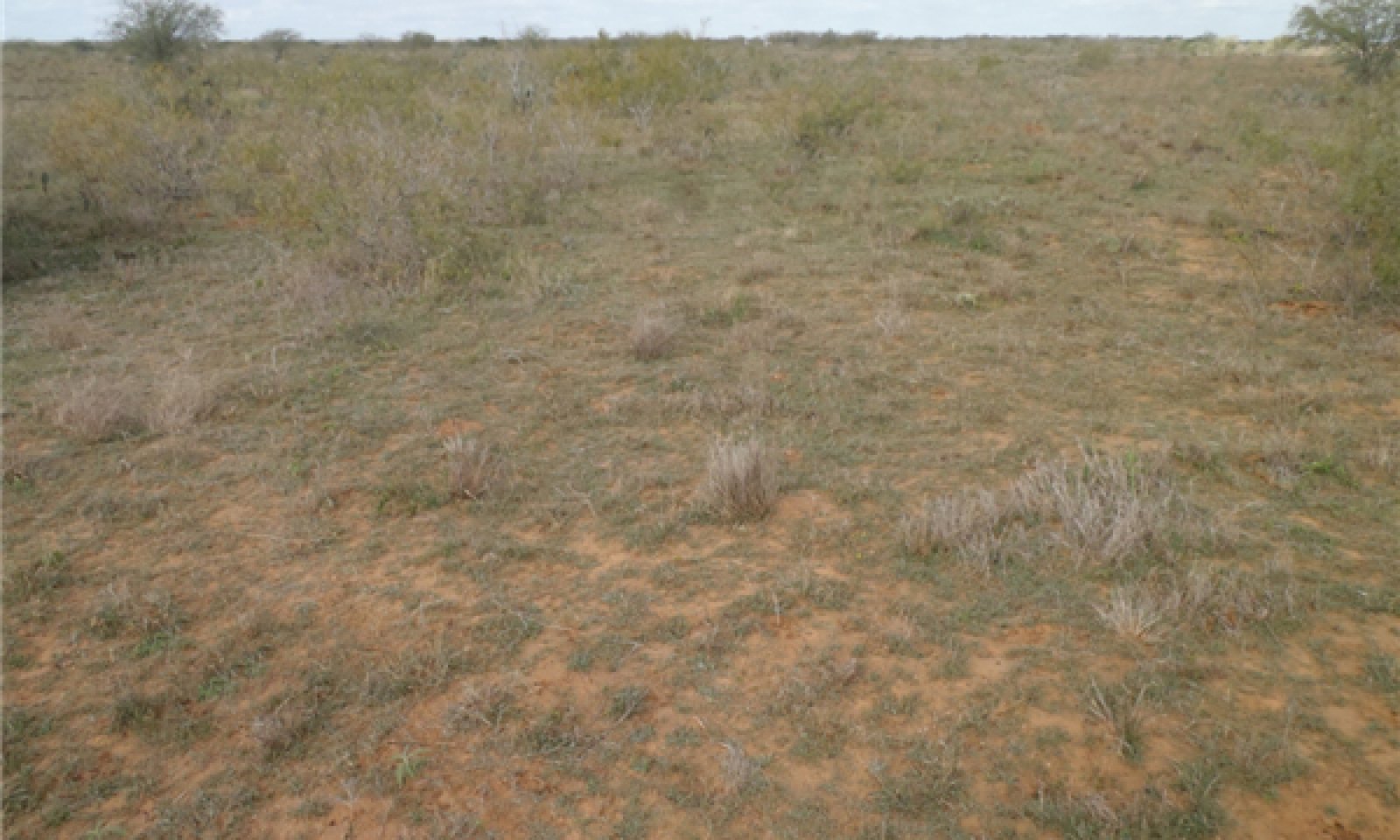

Natural Resources
Conservation Service
Ecological site R083CY022TX
Loamy Sand
Last updated: 9/19/2023
Accessed: 01/11/2025
General information
Provisional. A provisional ecological site description has undergone quality control and quality assurance review. It contains a working state and transition model and enough information to identify the ecological site.
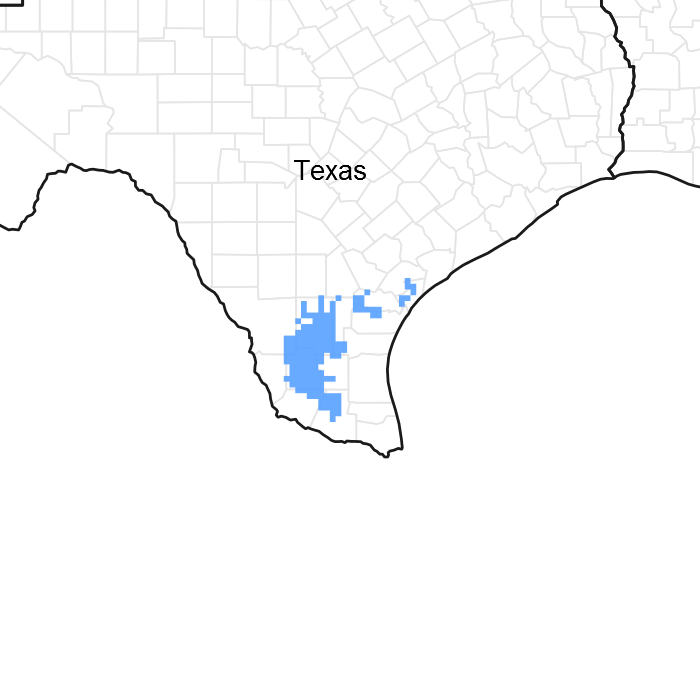
Figure 1. Mapped extent
Areas shown in blue indicate the maximum mapped extent of this ecological site. Other ecological sites likely occur within the highlighted areas. It is also possible for this ecological site to occur outside of highlighted areas if detailed soil survey has not been completed or recently updated.
MLRA notes
Major Land Resource Area (MLRA): 083C–Central Rio Grande Plain
Major Land Resource Area (MLRA) 83C makes up about 4,275 square miles (11,075 square kilometers). The towns of Freer, George West, and Hebbronville are in this area. The town of Alice is on the east edge of the area. U.S. Highways 59 and 281 cross the area. This area is comprised of inland, dissected coastal plains.
Classification relationships
USDA-Natural Resources Conservation Service, 2006.
-Major Land Resource Area (MLRA) 83C
Ecological site concept
The Loamy Sand site has a 20 to 40 inch sandy surface over a loamy or clayey subsoil. These sites are located on uplands or stream terraces.
Associated sites
| R083CY019TX |
Gray Sandy Loam |
|---|---|
| R083CY023TX |
Sandy Loam |
Similar sites
| R083AY022TX |
Loamy Sand |
|---|---|
| R083EY022TX |
Loamy Sand |
Table 1. Dominant plant species
| Tree |
Not specified |
|---|---|
| Shrub |
(1) Acacia greggii |
| Herbaceous |
(1) Heteropogon contortus |
Physiographic features
The site is found on nearly level to gently sloping soils on the western periphery of the Sandsheet Prairie of South Texas. Slopes range from 0 to 5 percent. This area is comprised of inland, dissected coastal plains.
Table 2. Representative physiographic features
| Landforms |
(1)
Coastal plain
> Sand sheet
(2) Coastal plain > Ridge |
|---|---|
| Runoff class | Low to medium |
| Flooding frequency | None |
| Ponding frequency | None |
| Elevation | 15 – 290 m |
| Slope | 0 – 5% |
| Aspect | Aspect is not a significant factor |
Climatic features
MLRA 83C is subtropical, subhumid on the western boundary and subtropical humid on the eastern boundary. Winters are dry and mild, and the summers are hot and humid. Tropical maritime air masses predominate throughout spring, summer, and fall. Modified polar air masses exert considerable influence during winter, creating a continental climate characterized by large variations in temperature. Peak rainfall, because of rain showers, occurs late in spring and a secondary peak occurs early in fall. Heavy thunderstorm activities increase in April, May, and June. July is hot and dry with little weather variations. Rainfall increases again in late August and September as tropical disturbances increase and become more frequent. Tropical air masses from the Gulf of Mexico dominate during the spring, summer, and fall. Prevailing winds are southerly to southeasterly throughout the year except in December when winds are predominately northerly.
Table 3. Representative climatic features
| Frost-free period (characteristic range) | 255-291 days |
|---|---|
| Freeze-free period (characteristic range) | 365 days |
| Precipitation total (characteristic range) | 584-660 mm |
| Frost-free period (actual range) | 255-347 days |
| Freeze-free period (actual range) | 365 days |
| Precipitation total (actual range) | 533-660 mm |
| Frost-free period (average) | 283 days |
| Freeze-free period (average) | 365 days |
| Precipitation total (average) | 635 mm |
Figure 2. Monthly precipitation range
Figure 3. Monthly minimum temperature range
Figure 4. Monthly maximum temperature range
Figure 5. Monthly average minimum and maximum temperature
Figure 6. Annual precipitation pattern
Figure 7. Annual average temperature pattern
Climate stations used
-
(1) FREER [USC00413341], Freer, TX
-
(2) CALLIHAM [USC00411337], Calliham, TX
-
(3) HEBBRONVILLE [USC00414058], Hebbronville, TX
-
(4) CHOKE CANYON DAM [USC00411720], Three Rivers, TX
-
(5) MCCOOK [USC00415721], Edinburg, TX
Influencing water features
This ecological site is not influenced by water from a wetland or stream. No ponding or flooding is expected for this ecological site during normal years.
Wetland description
N/A
Soil features
The soils are very deep, moderately well to well drained soils that formed in eolian sands over eolian deposits and alluvium of the Sand Sheet Prairie. The soils have fine sand and loamy fine sand surface textures. Subsoils increase in clay 20 to 40 inches below the surface. Soil series correlated to this site include: Bruni, Comitas, Delfina, Delmita, Leming, Papalote, Suerte, and Tasajal.
Table 4. Representative soil features
| Parent material |
(1)
Eolian deposits
–
sedimentary rock
(2) Alluvium – sedimentary rock |
|---|---|
| Surface texture |
(1) Loamy fine sand |
| Family particle size |
(1) Fine-loamy (2) Loamy |
| Drainage class | Moderately well drained to well drained |
| Permeability class | Moderate |
| Soil depth | 51 – 203 cm |
| Surface fragment cover <=3" | 0% |
| Surface fragment cover >3" | 0% |
| Available water capacity (0-101.6cm) |
10.16 – 12.7 cm |
| Calcium carbonate equivalent (0-101.6cm) |
0 – 2% |
| Electrical conductivity (0-101.6cm) |
0 – 2 mmhos/cm |
| Sodium adsorption ratio (0-101.6cm) |
0 – 5 |
| Soil reaction (1:1 water) (0-101.6cm) |
5.6 – 7.8 |
| Subsurface fragment volume <=3" (Depth not specified) |
0 – 3% |
| Subsurface fragment volume >3" (Depth not specified) |
0 – 3% |
Ecological dynamics
The first crude maps labeled this area of South Texas as Nuevo Santader (1746) and later as the Wild Horse Desert (1850). Now ecologists more commonly refer to it as the Tamaulipan Biotic Province or the Mesquite Acacia Woodland. The Loamy Sand ecological site is a component of this region and is in a transitional landscape between the Sandsheet Prairie and the Central Western and Lower Rio Grande Plains. As the Sandsheet tapers off, soils begin to have different soil surface textures and the depth of the soils start to vary from very shallow (less than 10 inches) to very deep (greater than 80 inches). The Loamy Sand ecological site exhibits characteristics of both the Sandsheet Prairie and the Rio Grande Plains.
Climate is an important, sometimes downplayed, force that affects the plant communities by impacting general plant composition and diversity at a regional scale. Over the past 130 years three climatic regimes have exhibited distinct weather patterns over the American South West that can be related to the establishment of different kinds of plants (e.g. C4 grasses versus C3 shrubs). Perennial warm season grasses and plants (usually C4) benefit most when spring and summer rainfall is consistent. On the opposite spectrum, mesquite, shrubs, and cool season annuals (usually C3) can take advantage of winter rains and can also conserve energy during hot dry summers.
Droughts are a common occurrence in South Texas and were often documented in letters and historical text. For example, Captain John S. “Rip” Ford mentioned the 1864 drought in his memoirs. He reported thousands of domestic animals dead around South Texas water holes and that the Nueces River was dry for miles. Maria Von Blucher commented in 1872 that, “as a result of the tremendous drought…half of all the cattle in Texas died…at every prominence where one can overlook the Nueces River, one might count more than 3,000 dead cattle.”
Despite the dry climate, this area of Texas was a mid/shortgrass prairie, which was attractive to ranchers and early settlers. In the mid-1800’s the number of grazing animals affecting the ecosystem began to rise dramatically. In general, numbers of wild horses and cattle increased from the 1840’s through the end of the Civil War. Sheep numbers expanded to outnumber both cattle and horses between 1867 and 1900, and peaked at numbers exceeding 2 million. Since that time sheep numbers have fallen dramatically and cattle have become the principal commercial livestock. The January 2013 Texas Livestock Inventory provided by the National Agricultural Statistics Service shows that less than 500,000 head of livestock including cattle, sheep, and goats are currently being raised south of the Nueces River.
Starting in the mid-1800’s the region saw wide anthropogenic changes in several environmental disturbance regimes. Research done to investigate the transition from grassland plant communities to shrubland communities in South Texas indicates that a significant successional change across the region began 100 to 200 years ago, and that stable carbon isotope ratios indicate C3 woody plants currently occupy sites once dominated by C4 grasses. When climate and/or other disturbance regimes change to favor the establishment and spread of woody plants a transition from grassland to shrubland will occur. As grazing use increases past sustainable levels mulch, litter, and other types of ground cover start to decrease, including standing herbaceous material. The plant community structure would also change slowly from a mid/shortgrass prairie to a short grass prairie with an increase in bare ground, annual forbs, and perennial woody species. This would have had a significant impact on water runoff and infiltration rates as well as soil temperatures and historic fire regimes.
A grassland community has the intrinsic ability to compete with woody species for available water and nutrients in the soil when they are growing in the same space at the same time. Their fibrous and expansive root systems are better adapted to use the top 12 to 16 inches of the soil and there appears to be a critical one to two year period during which mesquite seedlings might be in acute competition with grasses for soil resources. As herbaceous cover decreases bare ground increases, providing more opportunity for woody species to germinate and establish. The amount of herbaceous ground cover can also have a large impact on soil surface temperatures. The higher temperature extremes of bare soil may prevent seed germination of both grasses and shrubs creating a negative feedback loop which is only broken when some type of ground cover is established.
Climate and unsustainable grazing pressure have played large roles in the conversion of South Texas grasslands to what is now called “brush country”, but another important factor is a change in the historic fire regime. The range of woody species has not significantly changed in the past 300 to 500 years, but the stature and density of shrub species has greatly increased. The historic fire regime of South Texas was highly variable with fires every five to thirty years. The variability of fires across the region would have been driven by several factors including fine fuel load but, at a local level, fires would have been frequent enough to prevent woody plant seedlings from maturing and dominating a particular area. Grasses are much better adapted to survive periodic fires and have faster regrowth rates than most shrub species but, once established; brush species in South Texas have shown the tendency to survive fires because of their re-sprouting characteristics.
Plant communities will differ across the MLRA because of the naturally occurring variability in weather, soils, and aspect. The reference plant community is not necessarily the management goal; other vegetative states may be desired plant communities if the Range Health assessments are in the moderate and above category. The biological processes on this ecological site are complex. Therefore, representative values are presented in a land management context. The species lists are representative and are not botanical descriptions of all species occurring, or potentially occurring, on this ecological site. They are not intended to cover every situation or the full range of conditions, species, and responses for the ecological site.
State and transition model
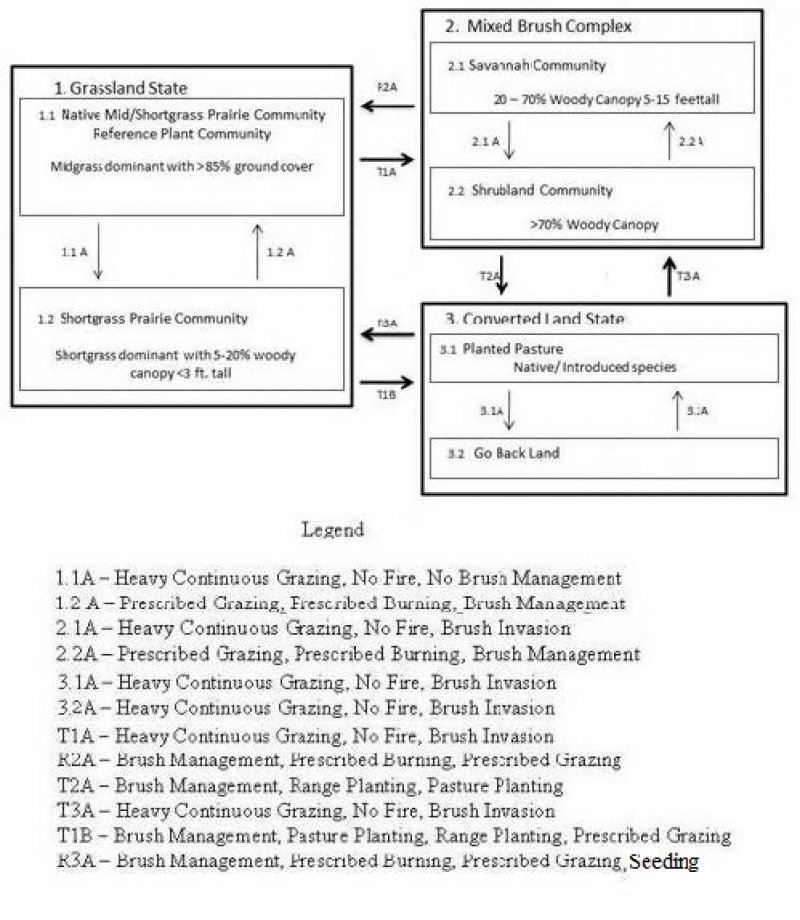
Figure 8. STM
More interactive model formats are also available.
View Interactive Models
More interactive model formats are also available.
View Interactive Models
Click on state and transition labels to scroll to the respective text
Ecosystem states
| T1A | - | Absence of disturbance and natural regeneration over time, coupled with excessive grazing pressure |
|---|---|---|
| T1B | - | Extensive soil disturbance followed by seeding with improved forage species |
| R2A | - | Reintroduction of historic disturbance return intervals |
| T2A | - | Extensive soil disturbance followed by seeding improved forage species |
| T3A | - | Absence of disturbance and natural regeneration over time, coupled with excessive grazing pressure |
State 1 submodel, plant communities
State 2 submodel, plant communities
State 3 submodel, plant communities
State 1
Grassland
Dominant plant species
-
silver beardgrass (Bothriochloa laguroides ssp. torreyana), grass
-
Arizona cottontop (Digitaria californica), grass
Community 1.1
Native Mid/Shortgrass Prairie
Because of a lack of reference communities, the interpretive information for this plant community is derived from previously developed range site descriptions and professional consensus of range trained field staff. This plant community is a productive mid/shortgrass prairie with a high diversity of forb species and occasional woody plants. The plant structure is maintained by a grazing and fire regime which recycles organic matter and nutrients from standing herbaceous material and prevents woody species from establishing dominance on the ecological site. This plant community is resistant to change and can persist through periodic droughts and other types of disturbance. On the other hand, it is not very resilient if herbaceous production and ground cover are dramatically reduced on a regular basis.
Figure 9. Annual production by plant type (representative values) or group (midpoint values)
Table 5. Annual production by plant type
| Plant type | Low (kg/hectare) |
Representative value (kg/hectare) |
High (kg/hectare) |
|---|---|---|---|
| Grass/Grasslike | 1429 | 2623 | 3811 |
| Forb | 168 | 308 | 448 |
| Shrub/Vine | 84 | 151 | 224 |
| Total | 1681 | 3082 | 4483 |
Table 6. Ground cover
| Tree foliar cover | 0% |
|---|---|
| Shrub/vine/liana foliar cover | 5-10% |
| Grass/grasslike foliar cover | 80-90% |
| Forb foliar cover | 10-20% |
| Non-vascular plants | 0% |
| Biological crusts | 0% |
| Litter | 5-10% |
| Surface fragments >0.25" and <=3" | 0.0-0.5% |
| Surface fragments >3" | 0% |
| Bedrock | 0% |
| Water | 0% |
| Bare ground | 0-15% |
Table 7. Canopy structure (% cover)
| Height Above Ground (m) | Tree | Shrub/Vine | Grass/ Grasslike |
Forb |
|---|---|---|---|---|
| <0.15 | – | 0-1% | 80-90% | 10-20% |
| >0.15 <= 0.3 | – | 0-1% | 80-90% | 10-20% |
| >0.3 <= 0.6 | – | 5-10% | 70-90% | 10-20% |
| >0.6 <= 1.4 | – | 5-10% | 70-90% | 5-10% |
| >1.4 <= 4 | – | – | – | – |
| >4 <= 12 | – | – | – | – |
| >12 <= 24 | – | – | – | – |
| >24 <= 37 | – | – | – | – |
| >37 | – | – | – | – |
Figure 10. Plant community growth curve (percent production by month). TX5125, Midgrass Grassland Community. Warm-season production from grass, forbs, and woody species..
| Jan | Feb | Mar | Apr | May | Jun | Jul | Aug | Sep | Oct | Nov | Dec |
|---|---|---|---|---|---|---|---|---|---|---|---|
| J | F | M | A | M | J | J | A | S | O | N | D |
| 1 | 1 | 5 | 15 | 20 | 20 | 5 | 5 | 10 | 10 | 5 | 3 |
Community 1.2
Shortgrass Prairie

Figure 11. 1.2 Shortgrass Prairie Community
This community phase occurs as the taller, more productive grasses are slowly replaced by short grasses and forbs. Threeawn species (Aristida spp.), hooded windmillgrass (Chloris cucullata), tumble lovegrass (Eragrostis sessilispica), fall witchgrass (Digitaria cognate), grass bur (Cenchrus spinifex), thin paspalum (Paspalum setaceum), hairy grama (Bouteloua hirsute), and Rio Grande bristlegrass (Setaria reverchonii subsp ramiseta) are common grass species that increase in abundance. The annual forb and grass community is highly variable but responds quickly to rainfall events. Some common forbs include palafoxia (Palafoxia spp.), snake cotton (Froelichia floridana), annual and perennial crotons (Croton spp.), and viperina (Zornia bracteata). Mesquite (Prosopis glandulosa) and hogplum (Colubrina texensis) are the first woody species to establish.
Figure 12. Annual production by plant type (representative values) or group (midpoint values)
Table 8. Annual production by plant type
| Plant type | Low (kg/hectare) |
Representative value (kg/hectare) |
High (kg/hectare) |
|---|---|---|---|
| Grass/Grasslike | 1233 | 2186 | 3138 |
| Shrub/Vine | 224 | 476 | 729 |
| Forb | 224 | 420 | 616 |
| Total | 1681 | 3082 | 4483 |
Figure 13. Plant community growth curve (percent production by month). TX5128, Shortgrass Dominant Community. Shortgrass dominates the site with decreasing midgrasses and increasing shrubs..
| Jan | Feb | Mar | Apr | May | Jun | Jul | Aug | Sep | Oct | Nov | Dec |
|---|---|---|---|---|---|---|---|---|---|---|---|
| J | F | M | A | M | J | J | A | S | O | N | D |
| 1 | 1 | 5 | 15 | 20 | 21 | 5 | 5 | 10 | 10 | 5 | 2 |
Pathway 1.1A
Community 1.1 to 1.2
This pathway represents a slow but continuous reduction in herbaceous plant production which affects many different ecological processes. Drought and grazing pressure are the main drivers for this transition, which in turn affect the fire regime. The larger bunchgrass species lose dominance and are gradually replaced with short grasses and forbs as litter cover is reduced and bare ground increases.
Pathway 1.2A
Community 1.2 to 1.1
Grazing management is key to restoring the Mid/Shortgrass Prairie Community (1.1). Sustainable grazing keeps pressure off target grass species and allows enough fine fuel to build up and support prescribed burns. In this phase fire is an effective tool that can be used to suppress woody plants and promote the grass and forb community. A prescribed burn plan with the goal of suppressing brush in the grassland state should initially be designed to have burns every three to five years. In some cases, burning may not be feasible because of weather conditions or ranch management issues. Currently, prescribed burns may also have unintended results like increased buffelgrass (Pennisetum ciliare) and Kleberg bluestem (Dichanthium annulatum), and tanglehead (Heteropogon contortus). In these cases, mechanical brush control practices that remove the rootcrown of re-sprouting species or herbicide that can kill target species without ground disturbance are also effective. An integrated brush management plan which utilizes fire in combination with mechanical and chemical treatments can be very effective in suppressing brush encroachment.
Community 2.1
Savannah
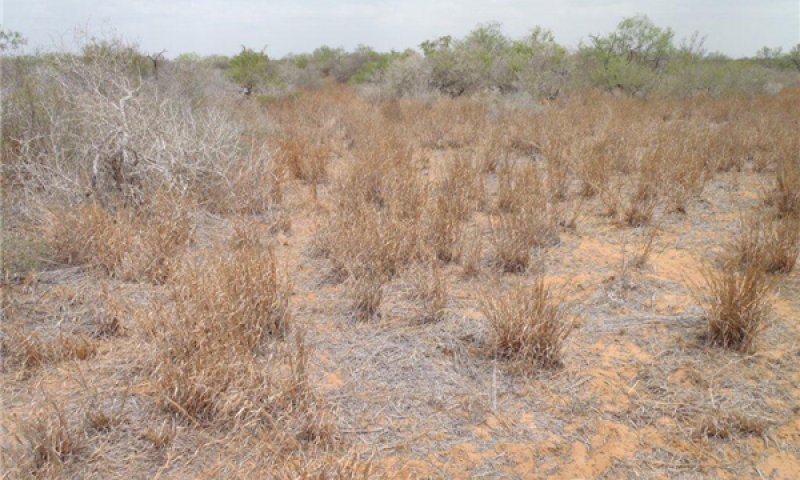
Figure 14. 2.1 Savannah Community
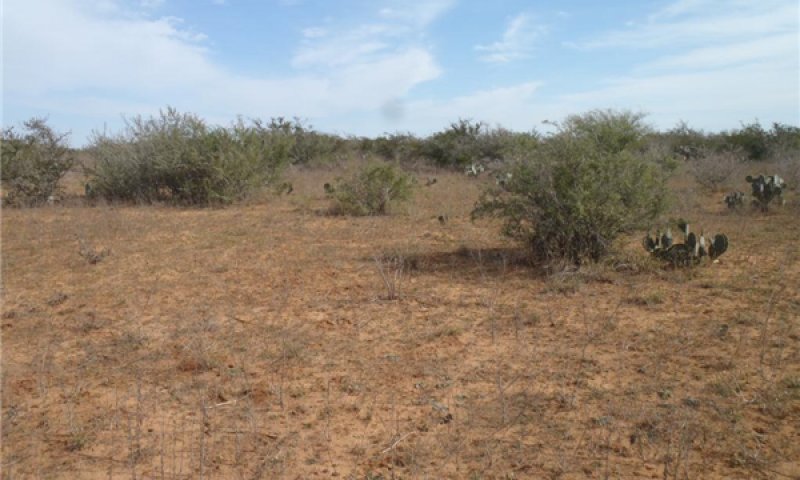
Figure 15. 2.1 Savannah Community
This community phase is a complex of grasses, forbs, and shrubs. The woody component has established and grown tall enough to survive periodic fire. Research in South Texas has shown that different plant species are recruited into the plant community at different stages of succession. Mesquite and hogplum are commonly the first to appear followed by lime pricklyash (Zanthoxylum fagara), granjeno (Celtis ehrenbergiana), brasil (Condalia hookeri), Texas persimmon (Diospyros texana), catclaw acacia (Acacia greggii), lantana (Lantana urticoides), leather stem (Jatropha dioica), and prickly pear (Opuntia engelmannii). As brush mottes develop, desert yaupon (Schaefferia cuneifloia), elbowbush (Forestiera pubescens), wolf berry (Lycium berlandieri), coma (Sideroxylon celastrinum), and lotebush (Ziziphus obtusifolia) will also begin to appear. Blackbrush acacia (Acacia rigidula) generally occurs within proximity of the soils associated with the Red Sandy Loam ecological site. The brush component of this ecological site tends to form discrete mottes with single or multiple species. This phase can be stable for more than 20 years before brush mottes coalesce and form large continuous areas. The herbaceous component can be similar in composition to the Grassland State, but grass production will continue to decrease while bare ground and forbs increase. In this phase introduced grasses like guineagrass (Urochloa maxima), and buffelgrass can increase and invade the native plant community. Tanglehead is another species that will dominate large areas under the right circumstances. Bare ground in this phase can typically range from 5 to 25 percent and gaps in the brush canopy range from 2 to 65 feet.
Figure 16. Annual production by plant type (representative values) or group (midpoint values)
Table 9. Annual production by plant type
| Plant type | Low (kg/hectare) |
Representative value (kg/hectare) |
High (kg/hectare) |
|---|---|---|---|
| Grass/Grasslike | 897 | 1681 | 2466 |
| Shrub/Vine | 560 | 981 | 1401 |
| Forb | 224 | 420 | 616 |
| Total | 1681 | 3082 | 4483 |
Figure 17. Plant community growth curve (percent production by month). TX5130, Short/Midgrass Shrubland Complex 20-50% woody canopy. Shrubland Community with 20-50% woody canopy..
| Jan | Feb | Mar | Apr | May | Jun | Jul | Aug | Sep | Oct | Nov | Dec |
|---|---|---|---|---|---|---|---|---|---|---|---|
| J | F | M | A | M | J | J | A | S | O | N | D |
| 2 | 2 | 5 | 10 | 18 | 15 | 5 | 9 | 15 | 9 | 5 | 5 |
Community 2.2
Shrubland
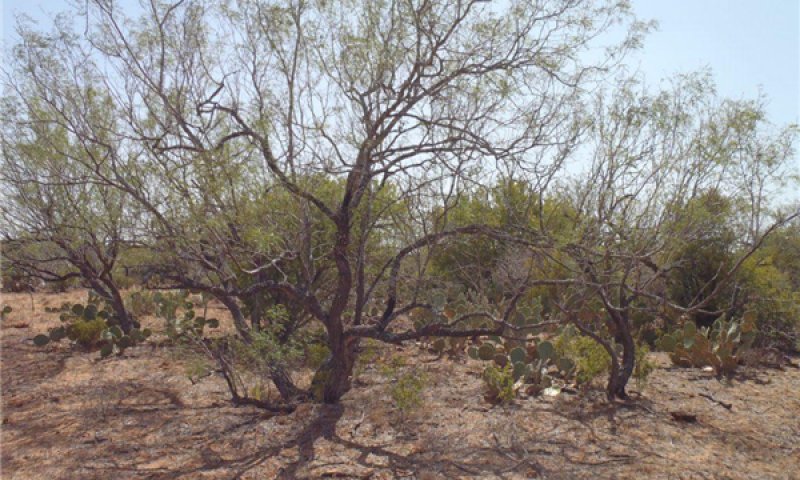
Figure 18. 2.2 Shrubland Communtiy
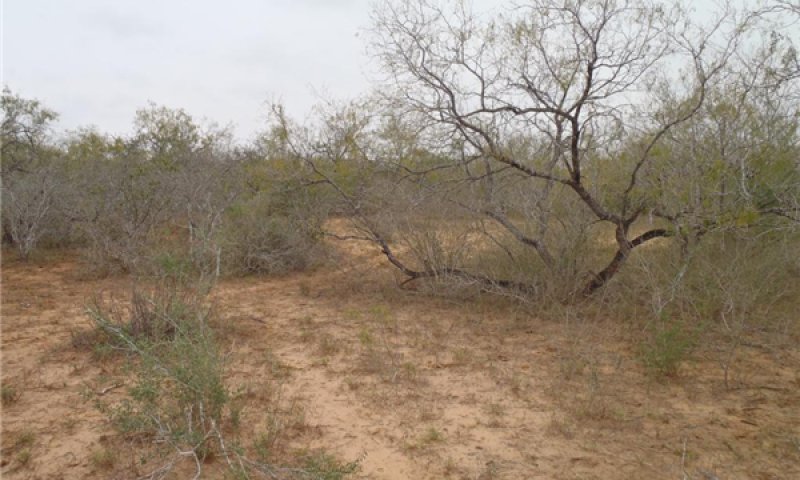
Figure 19. 2.2 Shrubland Communtiy
The woodland phase of the brush state develops as brush species coalesce into large scattered mottes. A continuous brush canopy develops within each motte and the plant composition is almost exclusively composed of woody species. Mottes tend to be isolated “islands” within the Savannah Phase (2.1) and will not cover large areas of the landscape. Herbaceous production is very low and will include plants like three awn species, hooded windmillgrass, and Rio Grande bristlegrass. Although mesquite is very common, other co-dominant species include hog plum and catclaw acacia. Different sub-canopy brush species that will typically make up less than 15 percent of the canopy cover include brasil, lime pricklyash, prickly pear, Texas persimmon, and granjeno.
Figure 20. Annual production by plant type (representative values) or group (midpoint values)
Table 10. Annual production by plant type
| Plant type | Low (kg/hectare) |
Representative value (kg/hectare) |
High (kg/hectare) |
|---|---|---|---|
| Shrub/Vine | 1345 | 2130 | 2914 |
| Grass/Grasslike | 224 | 673 | 1121 |
| Forb | 112 | 280 | 448 |
| Total | 1681 | 3083 | 4483 |
Figure 21. Plant community growth curve (percent production by month). TX5131, Shrubland Complex Community, >50% woody canopy. Woodland Community with 50-80% woody canopy cover..
| Jan | Feb | Mar | Apr | May | Jun | Jul | Aug | Sep | Oct | Nov | Dec |
|---|---|---|---|---|---|---|---|---|---|---|---|
| J | F | M | A | M | J | J | A | S | O | N | D |
| 2 | 2 | 5 | 10 | 18 | 15 | 5 | 9 | 15 | 9 | 5 | 5 |
Pathway 2.1A
Community 2.1 to 2.2


The transition from Savannah (2.1) to Shrubland (2.2) occurs slowly over time and is highly dependent on weather, ground cover, competition from grasses and seed dispersal. Because there are so many factors, it is difficult to determine which areas are most susceptible to woody plant encroachment. This plant community can have a large amount of bare ground and relatively low amounts of herbaceous production, putting it constantly at risk of brush encroachment. The Savannah Phase’s stability is due to the low water holding capacity of the soil surface, which may make it difficult for woody plants to germinate and survive in open areas with no ground cover.
Pathway 2.2A
Community 2.2 to 2.1


The Shrubland Community (2.2) is distinguished from the Savannah Community (2.1) by the increase in woody plant canopy cover, which negatively affects herbaceous production. Extreme dry weather can cause plant mortality and a decrease in woody cover, but this is a cyclic process and woody cover density can recover. Mechanical brush control will be necessary to restore the Savannah Community (2.1), because grazing and fire will not have large impacts on mature brush mottes.
Community 3.1
Planted Pasture
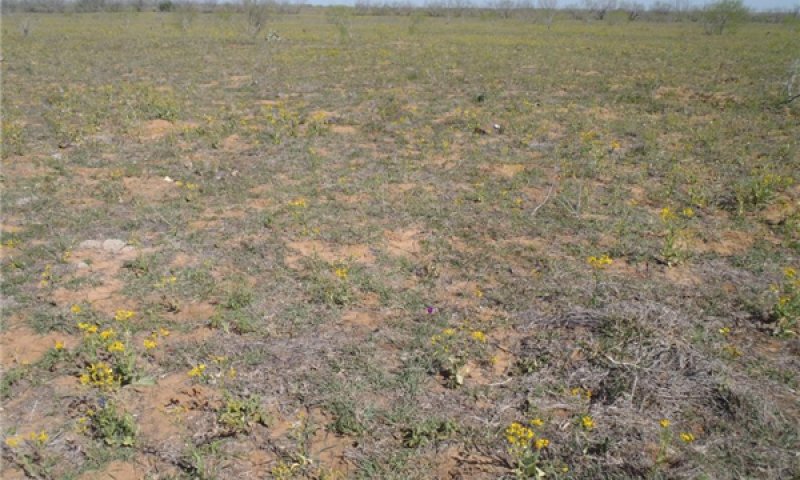
Figure 22. 3.1 Planted Pasture Community
This plant community is not common and is hard to maintain, but can be developed. Introduced grasses like Wilman’s lovegrass and buffelgrass have been used by land managers to create pastures. Inputs such as herbicide and adequate precipitation are necessary to maintain high productivity. Now, because of the availability of seed, landowners can also replant with native species. For maintenance, herbicides must be used to control woody seedlings that seek to invade as soon as the pasture is established. Not only is there a long-lived seed source of mesquite and other woody species, additional seed are brought in by grazing animals and domestic livestock.
Figure 23. Annual production by plant type (representative values) or group (midpoint values)
Table 11. Annual production by plant type
| Plant type | Low (kg/hectare) |
Representative value (kg/hectare) |
High (kg/hectare) |
|---|---|---|---|
| Grass/Grasslike | 560 | 1681 | 2802 |
| Total | 560 | 1681 | 2802 |
Figure 24. Plant community growth curve (percent production by month). TX5132, Converted Land Community - Pastureland. Converting into pastureland by planting native and introduced grass species..
| Jan | Feb | Mar | Apr | May | Jun | Jul | Aug | Sep | Oct | Nov | Dec |
|---|---|---|---|---|---|---|---|---|---|---|---|
| J | F | M | A | M | J | J | A | S | O | N | D |
| 1 | 1 | 5 | 15 | 20 | 20 | 5 | 5 | 15 | 8 | 4 | 1 |
Community 3.2
Go Back Land
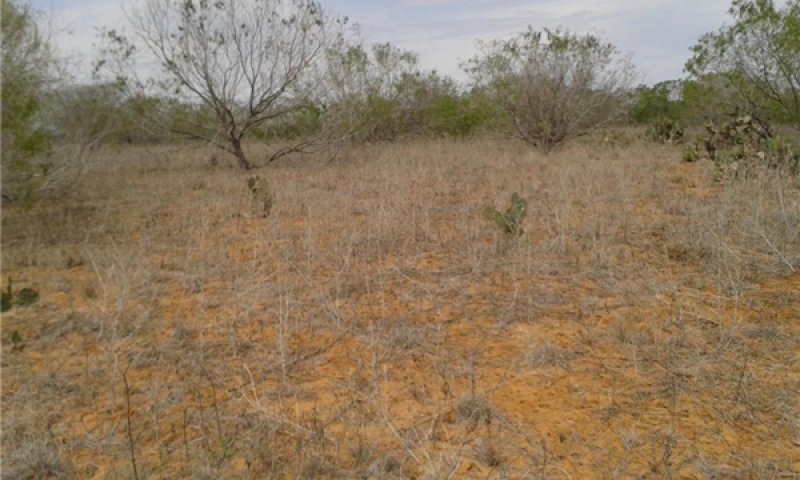
Figure 25. 3.2 Go Back Land Community
This community develops after land has been planted to pasture and then left to fallow without management inputs. It can also develop after a mechanical brush management practice has been applied during poor weather conditions or not followed up with appropriate management practices. It is typified by low plant diversity, the dominance of woody species, very little herbaceous grass production, high amounts of annual forbs, and bare ground. Because of the seed bank present in the soil, and the constant addition of new seed from grazing/browsing animals and seed eating birds, re-infestation of woody seedlings can happen in less than five years. The production and plant community structure are highly variable in the Go Back Land Community (3.2).
Figure 26. Plant community growth curve (percent production by month). TX5136, Converted Land Community - Woody Seedling Encroachment. Converted Land Community that has been encroached by woody seedlings due to abandonment of crop and pastureland..
| Jan | Feb | Mar | Apr | May | Jun | Jul | Aug | Sep | Oct | Nov | Dec |
|---|---|---|---|---|---|---|---|---|---|---|---|
| J | F | M | A | M | J | J | A | S | O | N | D |
| 2 | 2 | 5 | 10 | 18 | 15 | 5 | 9 | 15 | 9 | 5 | 5 |
Pathway 3.1A
Community 3.1 to 3.2


The transition from Planted Pasture (3.1) to Go Back Land (3.2) occurs when pastures are left to fallow without brush management. Woody species gain a competitive advantage and a low diversity plant community typically develops.
Pathway 3.2A
Community 3.2 to 3.1


After an area has reverted to Go Back Land (3.2), land managers may want to utilize the ecological site as pasture again. From a species diversity and wildlife habitat perspective, it is usually a good idea to reclaim an area that has already been manipulated in the past, instead of clearing another, more species rich, part of the management area. Once in this phase, mechanical brush control will be necessary, and a seed bed will need to be prepared to replant introduced grasses for pasture.
Transition T1A
State 1 to 2
The transition from the Grassland State (1) to the Mixed Brush Complex (2) can happen relatively quickly if conditions favor woody plant seedlings. The shortgrass plant community is an at risk phase of the Grassland State. As bare ground increases and competition from grasses decrease, woody plants have a chance to germinate. Within as little as five years after seedling establishment, mesquite may grow too large to be effectively managed with grazing or fire, especially if the fine fuel needed to carry an effective burn is not being produced. Other brush species native to this ecological site will take significantly longer to grow out of the fire control range, but mesquite acts as a nursery plant which speeds up the transition process. Discrete mottes of brush will begin to develop as the woody plants grow, pushing the plant community into a Mixed Brush Complex (2).
Transition T1B
State 1 to 3
Land managers may want to utilize this ecological site as pastureland. An on-site evaluation should be made before any mechanical preparation, because the depth of the soil to a petrocalcic layer varies. After the land has been cleared and an appropriate seedbed prepared the land can be planted to introduced grasses for pasture.
Restoration pathway R2A
State 2 to 1
Land managers may want to restore this ecological site to the Native Grassland State (1). Once in the Mixed Brush Complex (2) mechanical or chemical brush control will be necessary to make the transition. The restoration process is heavily dependent on favorable weather and patience. Land managers can plant native seed to speed up restoration efforts or can rely on seed that is already in the soil. Grazing pressure on restoration sites should be deferred for a minimum of one growing season, but it is often necessary to defer livestock grazing completely or carefully graze for years before the desired plant community can develop.
Transition T2A
State 2 to 3
Land managers may want to utilize this ecological site as pastureland. Once in the Mixed Brush Complex (2), mechanical brush control will be necessary. Many species of brush are capable of re-sprouting after top removal, which is an important factor to consider when deciding how to clear the land to plant pasture. An on-site evaluation should also be made before any mechanical method is used, because the depth of the soil to a petrocalcic layer varies. After the land has been cleared and an appropriate seedbed prepared the land can be planted to introduced grasses for pasture.
Transition T3A
State 3 to 2
In time, this ecological site will revert to the Mixed Brush Complex (2) on its own, but usually this timeline is impractical for landowners. Prescribed grazing along with various brush management practices will be necessary to achieve this transition and allow the mixed brush community to develop. This phase is very unproductive for herbaceous plants and it could take years for desirable plant species to begin to reestablish.
Additional community tables
Table 12. Community 1.1 plant community composition
| Group | Common name | Symbol | Scientific name | Annual production (kg/hectare) | Foliar cover (%) | |
|---|---|---|---|---|---|---|
|
Grass/Grasslike
|
||||||
| 1 | Mid/Tallgrasses | 560–1457 | ||||
| silver beardgrass | BOLAT | Bothriochloa laguroides ssp. torreyana | 84–336 | – | ||
| Arizona cottontop | DICA8 | Digitaria californica | 84–336 | – | ||
| tanglehead | HECO10 | Heteropogon contortus | 84–336 | – | ||
| shore little bluestem | SCLI11 | Schizachyrium littorale | 84–336 | – | ||
| multiflower false Rhodes grass | TRPL3 | Trichloris pluriflora | 84–336 | – | ||
| 2 | Midgrasses | 644–1793 | ||||
| hooded windmill grass | CHCU2 | Chloris cucullata | 56–224 | – | ||
| pink pappusgrass | PABI2 | Pappophorum bicolor | 56–224 | – | ||
| Rio Grande bristlegrass | SERER | Setaria reverchonii ssp. ramiseta | 56–224 | – | ||
| southwestern bristlegrass | SESC2 | Setaria scheelei | 56–224 | – | ||
| plains bristlegrass | SEVU2 | Setaria vulpiseta | 56–224 | – | ||
| sand dropseed | SPCR | Sporobolus cryptandrus | 56–224 | – | ||
| 3 | Shortgrasses | 224–560 | ||||
| threeawn | ARIST | Aristida | 34–56 | – | ||
| hairy grama | BOHI2 | Bouteloua hirsuta | 34–56 | – | ||
| coastal sandbur | CESP4 | Cenchrus spinifex | 34–56 | – | ||
| red lovegrass | ERSE | Eragrostis secundiflora | 34–56 | – | ||
| tumble lovegrass | ERSE2 | Eragrostis sessilispica | 34–56 | – | ||
| thin paspalum | PASE5 | Paspalum setaceum | 34–56 | – | ||
| slim tridens | TRMU | Tridens muticus | 34–56 | – | ||
|
Forb
|
||||||
| 4 | Forbs | 168–448 | ||||
| purple threeawn | ARPU9 | Aristida purpurea | 33–80 | – | ||
| slender grama | BORE2 | Bouteloua repens | 33–80 | – | ||
| Pan American balsamscale | ELTR4 | Elionurus tripsacoides | 33–80 | – | ||
| thin paspalum | PASE5 | Paspalum setaceum | 33–80 | – | ||
| fringed signalgrass | URCI | Urochloa ciliatissima | 33–80 | – | ||
| Forb, annual | 2FA | Forb, annual | 11–39 | – | ||
| partridge pea | CHFA2 | Chamaecrista fasciculata | 11–22 | – | ||
| healing croton | CRAR2 | Croton argyranthemus | 11–22 | – | ||
| hogwort | CRCA6 | Croton capitatus | 11–22 | – | ||
| Indian blanket | GAPU | Gaillardia pulchella | 11–22 | – | ||
| leatherstem | JADI | Jatropha dioica | 11–22 | – | ||
| trailing krameria | KRLA | Krameria lanceolata | 11–22 | – | ||
| lemon beebalm | MOCI | Monarda citriodora | 11–22 | – | ||
| sand palafox | PAHO | Palafoxia hookeriana | 11–22 | – | ||
| Texas palafox | PATEA | Palafoxia texana var. ambigua | 11–22 | – | ||
| silverleaf nightshade | SOEL | Solanum elaeagnifolium | 11–22 | – | ||
| uhaloa | WAIN | Waltheria indica | 11–22 | – | ||
| viperina | ZOBR | Zornia bracteata | 11–22 | – | ||
|
Shrub/Vine
|
||||||
| 5 | Shrubs/Vines | 84–224 | ||||
| vervain | VERBE | Verbena | 8–67 | – | ||
| Brazilian bluewood | COHO | Condalia hookeri | 11–22 | – | ||
| Texan hogplum | COTET | Colubrina texensis var. texensis | 11–22 | – | ||
| Texas persimmon | DITE3 | Diospyros texana | 11–22 | – | ||
| spiny hackberry | CEEH | Celtis ehrenbergiana | 11–22 | – | ||
| honey mesquite | PRGLG | Prosopis glandulosa var. glandulosa | 0–22 | – | ||
| lime pricklyash | ZAFA | Zanthoxylum fagara | 11–22 | – | ||
| catclaw acacia | ACGR | Acacia greggii | 11–22 | – | ||
| dayflower | COMME | Commelina | 8–18 | – | ||
| purple dalea | DALA4 | Dalea lasiathera | 8–18 | – | ||
| coastal indigo | INMI | Indigofera miniata | 8–18 | – | ||
| dotted blazing star | LIPU | Liatris punctata | 8–18 | – | ||
| sensitive plant | MIMOS | Mimosa | 8–18 | – | ||
| least snoutbean | RHMI4 | Rhynchosia minima | 8–18 | – | ||
| awnless bushsunflower | SICA7 | Simsia calva | 8–18 | – | ||
| stretchberry | FOPU2 | Forestiera pubescens | 6–17 | – | ||
| Berlandier's wolfberry | LYBE | Lycium berlandieri | 6–17 | – | ||
| algerita | MATR3 | Mahonia trifoliolata | 6–17 | – | ||
| Texas pricklypear | OPENL | Opuntia engelmannii var. lindheimeri | 6–17 | – | ||
| lotebush | ZIOB | Ziziphus obtusifolia | 6–17 | – | ||
| desert yaupon | SCCU4 | Schaefferia cuneifolia | 6–17 | – | ||
| anacahuita | COBO2 | Cordia boissieri | 0–17 | – | ||
| catclaw acacia | ACGRW | Acacia greggii var. wrightii | 6–17 | – | ||
| blackbrush acacia | ACRI | Acacia rigidula | 0–17 | – | ||
| Schaffner's wattle | ACSC2 | Acacia schaffneri | 6–17 | – | ||
| Rio Grande beebrush | ALMA9 | Aloysia macrostachya | 6–17 | – | ||
| Texan goatbush | CAERT | Castela erecta ssp. texana | 6–17 | – | ||
Interpretations
Animal community
As a historic tall/midgrass prairie, this site was occupied by bison, antelope, deer, quail, turkey, and dove. This site was also used by many species of grassland songbirds, migratory waterfowl, and coyotes. This site now provides forage for livestock and is still used by quail, dove, migratory waterfowl, grassland birds, coyotes, and deer.
Feral hogs (Sus scrofa) can be found on most ecological sites in Texas. Damage caused by feral hogs each year includes, crop damage by rutting up crops, destroyed fences, livestock watering areas, and predation on native wildlife, and ground-nesting birds. Feral hogs have few natural predators, thus allowing their population to grow to high numbers.
Wildlife habitat is a complex of many different plant communities and ecological sites across the landscape. Most animals use the landscape differently to find food, shelter, protection, and mates. Working on a conservation plan for the whole property, with a local professional, will help managers make the decisions that allow them to realize their goals for wildlife and livestock.
Grassland State (1): This state provides the maximum amount of forage for livestock such as cattle. It is also utilized by deer, quail and other birds as a source of food. When a site is in the reference plant community phase (1.1) it will also be used by some birds for nesting, if other habitat requirements like thermal and escape cover are near.
Tree/Shrubland (2): This state can be maintained to meet the habitat requirements of cattle and wildlife. Land managers can find a balance that meets their goals and allows them flexibility to manage for livestock and wildlife. Forbs for deer and birds like quail will be more plentiful in this state. There will also be more trees and shrubs to provide thermal and escape cover for birds as well as cover for deer.
Converted Land State (3): The quality of wildlife habitat this site will produce is extremely variable and is influenced greatly by the timing of rain events. This state is often manipulated to meet landowner goals. If livestock production is the main goal, it can be converted to pastureland. It can also be planted to a mix of grasses and forbs that will benefit both livestock and wildlife. A mix of forbs in the pasture could attract pollinators, birds and other types of wildlife. Food plots can also be planted to provide extra nutrition for deer.
This rating system provides general guidance as to animal preference for plant species. It also indicates possible competition between kinds of herbivores for various plants. Grazing preference changes from time to time, especially between seasons, and between animal kinds and classes. Grazing preference does not necessarily reflect the ecological status of the plant within the plant community. For wildlife, plant preferences for food and plant suitability for cover are rated. Refer to habitat guides for a more complete description of a species habitat needs.
Hydrological functions
Peak rainfall periods occur in May and June from thunderstorms and in September and October from tropical systems. Rainfall events may be high, three to five inches, and intense. Extended periods (45 to 60 days) of little to no rainfall during the growing season are common. Because of the flat topography, erosion is minimal, however on more sloping aspects (greater than three percent), erosion may be very significant.
Recreational uses
The area is often used for hunting and photography.
Wood products
In the prairie state, no wood products are available. In the Shrubland State, the ecological site may grow large numbers of mesquite trees and these can be cut for firewood and barbecue wood.
Other products
Landowners have the opportunity to explore the many facets of ecotourism, and the potential of the natural resources of their property, to create value from their land.
Supporting information
Inventory data references
The data contained in this document is derived from analysis of inventories, clipping studies, and ecological interpretation from field evaluations.
Other references
Archer, S. 1995. Herbivore mediation of grass-woody plant interactions. Tropical Grasslands, 29:218-235.
Archer, S. 1995. Tree-grass dynamics in a Prosopis-thornscrub savanna parkland: reconstructing the past and predicting the future. Ecoscience, 2:83-99.
Archer, S. 1994. Woody plant encroachment into southwestern grasslands and savannas: rates, patterns and proximate causes. Ecological implications of livestock herbivory in the West, 13-68.
Archer, S., C. Scifres, C. R. Bassham, and R. Maggio. 1988. Autogenic succession in a subtropical savanna: conversion of grassland to thorn woodland. Ecological Monographs 58(2):110-127.
Archer, S. 1990. Development and stability of grass/woody mosaics in a subtropical savanna parkland, Texas, USA. Journal of Biogeography 17: 453-462.
Bond, W. J. What Limits Trees in C4 Grasslands and Savannas? Annual Review of Ecology, Evolution, and Systematics. 39:641-659.
De Leon, A. 2003. Itineraries of the De Léon Expeditions of 1689 and 1690. In Spanish Exploration in the Southwest, 1542-1706. Edited by H. E. Bolton. Charles Scribner’s Sons, New York, NY.
Dillehay T. 1974. Late quaternary bison population changes on the Southern Plains. Plains Anthropologist, 19:180-96.
Duaine, C. L. 1971. Caverns of Oblivion. Packrat Press, Oak Harbor, WA.
Everitt, J. H., D. L. Drawe, and R. I. Leonard. 2002. Trees, Shrubs, and Cacti of South Texas. Texas Tech University Press, Lubbock, TX.
Everitt, J. H., D. L. Drawe, and R. I. Lonard. 1999. Field Guide to the Broad-Leaved Herbaceous Plants of South Texas. Texas Tech University Press. Lubbock, TX.
Ford, J. S. 2010. Rip Ford’s Texas. University of Texas Press. Austin, TX.
Fulbright, T. E. and S. L. Beasom. 1987. Long-term effects of mechanical treatment on white-tailed deer browse. Wildlife Society Bulletin, 15:560-564.
Fulbright, T. E. and F. C. Bryant. 2003. The Wild Horse Desert: climate and ecology. The Ranch Management, 35-58.
Gilbert, L. E. 1982. An ecosystem perspective on the role of woody vegetation, especially mesquite, in the Tamaulipan biotic region of South Texas. Proceeding Symposium of the Tamaulipan Biotic Province, Corpus Christi, TX.
Hanselka, C. W., D. L. Drawe, and D. C. Ruthven, III. 2004. Management of South Texas Shrublands with prescribed fire. In Proceedings: Shrubland dynamics -- fire and water, 57-61.
Heitschmidt R. K., Stuth J. W., eds. 1991. Grazing management: an ecological perspective. Timberline Press, Portland, OR.
Inglis, J. M. 1964. A history of vegetation of the Rio Grande Plains. Texas Parks and Wildlife Department Bulletin No. 45, Austin, TX.
Jurena, P.N., and S. Archer. 2003. Woody Plant Establishment and Spatial Heterogeneity in Grasslands Ecology, 84(4):907-919.
Le Houerou, H. N. and J. Norwine. 1988. The ecoclimatology of South Texas. In Arid lands: today and tomorrow. Edited by E. E. Whitehead, C. F. Hutchinson, B. N. Timmesman, and R. G. Varady, 417-444. Westview Press, Boulder, CO.
Lehman, V. W. 1969. Forgotten legions: sheep in the Rio Grande Plains of Texas. Texas Western Press, University of Texas at El Paso, El Paso, TX.
McGinty, A. and D. N. Ueckert. 2001. The Brush Busters success story. Rangelands Archives, 23(6):3-8.
McLendon T. 1991. Preliminary description of the vegetation of South Texas exclusive of coastal saline zones. Texas Journal of Science, 43: 13-32
Neilson, R. P. 1987. Biotic regionalization and climatic controls in western North America. Vegetatio, 70(3): 135-147.
Norwine, J. 1978. Twentieth-century semiarid climates and climatic fluctuations in Texas and northeastern Mexico. Journal of Arid Environments, 1:313-325.
Norwine, J. and R. Bingham. 1986. Frequency and severity of droughts in South Texas: 1900-1983, 1-17. In Livestock and wildlife management during drought. Edited by R. D. Brown. Caesar Kleberg Wildlife Research Institute, Kingsville, TX.
Parvin, R. W. 2003. Rio Bravo Resource Conservation and Development. Llanos Mestenos South Texas Heritage Trail. Zapata, TX.
Rappole, J. H. and G. W. Blacklock. 1994. A field guide: Birds of Texas. Texas A&M University Press, College Station, TX.
Schmidley, D. J. 1983. Texas mammals east of the Balcones Fault zone. Texas A&M University Press. College Station, TX.
Scifres, C. J. and W. T. Hamilton. 1993. Prescribed burning for brushland management: the South Texas example. Texas A&M Press, College Station, TX.
Scifres C. J., W. T. Hamilton, J. R. Conner, J. M. Inglis, and G. A. Rasmussen. 1985. Integrated Brush Management Systems for South Texas: Development and Implementation. Texas Agricultural Experiment Station, College Station, TX.
Scifres, C. J., J.W. McAtee, and D. L. Drawe. 1980. Botanical, Edaphic, and Water Relationships of Gulf Cordgrass (Spartina spartinae [Trin.] Hitchc.) and Associated Communities The Southwestern Naturalist 25(3):397-409.
Texas Parks and Wildlife Department. 2007. List of White-tailed Deer Browse and Ratings. District 8.
Vavra, M., W. A. Laycock, R. D. Pieper. 1994. Ecological Implications of livestock herbivory in the West. Society for Range Management. Denver, CO.
Weltz, M. A. and W. H. Blackburn. 1995. Water budget for south Texas rangelands. Journal of Range Management, 48:45-52.
Whittaker, R. H., L. E. Gilbert, and J. H. Connell. 1979. Analysis of a two-phase pattern in a mesquite grassland, Texas. Journal of Ecology, 67:935-52.
Wright, B. D., R. K. Lyons, J. C. Cathey, and S. Cooper. 2002. White-tailed deer browse preferences for South Texas and the Edwards Plateau. Texas Cooperative Extension Bulletin B-6130.
Contributors
Gary Harris, MSSL, NRCS, Robstown, Texas
Approval
Bryan Christensen, 9/19/2023
Acknowledgments
Technical reviewers and contributors include:
Clark Harshbarger, MSSL, NRCS, Robstown
Vivian Garcia, RMS, NRCS, Corpus Christi
Shanna Dunn, RSS, NRCS, Corpus Christi
Jason Hohlt, RMS, NRCS, Kingsville
Tyson Hart, RMS, NRCS, Nacogdoches
Rangeland health reference sheet
Interpreting Indicators of Rangeland Health is a qualitative assessment protocol used to determine ecosystem condition based on benchmark characteristics described in the Reference Sheet. A suite of 17 (or more) indicators are typically considered in an assessment. The ecological site(s) representative of an assessment location must be known prior to applying the protocol and must be verified based on soils and climate. Current plant community cannot be used to identify the ecological site.
| Author(s)/participant(s) | David Hinojosa |
|---|---|
| Contact for lead author | 361-241-0609, Zone 3 Rangeland Management Specialist |
| Date | 09/23/2013 |
| Approved by | Bryan Christensen |
| Approval date | |
| Composition (Indicators 10 and 12) based on | Annual Production |
Indicators
-
Number and extent of rills:
None. -
Presence of water flow patterns:
Few water flow pattens are normal for this site following intense rainfall events. -
Number and height of erosional pedestals or terracettes:
Pedestals would have been uncommon for this site. -
Bare ground from Ecological Site Description or other studies (rock, litter, lichen, moss, plant canopy are not bare ground):
Less than five percent bare ground. -
Number of gullies and erosion associated with gullies:
None. -
Extent of wind scoured, blowouts and/or depositional areas:
Slight soil erosion by wind can occur because of the loamy sand surface textures. -
Amount of litter movement (describe size and distance expected to travel):
Small-to-medium sized litter may move short distances during intense storms. -
Soil surface (top few mm) resistance to erosion (stability values are averages - most sites will show a range of values):
Soil surface is resistant to erosion. Soil stability class range is expected to be 4 to 6. -
Soil surface structure and SOM content (include type of structure and A-horizon color and thickness):
Soil surface horizons are 12 to 24 inches thick; reddish brown (5YR 5/4) loamy fine sand; weak, fine subangular blocky structure; clear smooth boundary; SOM is less than three percent. -
Effect of community phase composition (relative proportion of different functional groups) and spatial distribution on infiltration and runoff:
A high canopy cover of bunchgrass, rhizomatous grass, and stoliniferous grasses will help minimize runoff and maximize infiltration. Grasses should comprise approximately 90 percent of total annual production by weight. Shrubs will comprise about five percent by weight. -
Presence and thickness of compaction layer (usually none; describe soil profile features which may be mistaken for compaction on this site):
None. -
Functional/Structural Groups (list in order of descending dominance by above-ground annual-production or live foliar cover using symbols: >>, >, = to indicate much greater than, greater than, and equal to):
Dominant:
Midgrasses >Sub-dominant:
Mid/Tallgrasses >> Shortgrasses > Forbs > Shrubs/VinesOther:
Additional:
-
Amount of plant mortality and decadence (include which functional groups are expected to show mortality or decadence):
Potential for 5 to 15 percent plant mortality of perrenial bunchgrasses during extreme drought. -
Average percent litter cover (%) and depth ( in):
Litter is primarily herbaceous. -
Expected annual annual-production (this is TOTAL above-ground annual-production, not just forage annual-production):
1,500 to 4,000 pounds per acre. -
Potential invasive (including noxious) species (native and non-native). List species which BOTH characterize degraded states and have the potential to become a dominant or co-dominant species on the ecological site if their future establishment and growth is not actively controlled by management interventions. Species that become dominant for only one to several years (e.g., short-term response to drought or wildfire) are not invasive plants. Note that unlike other indicators, we are describing what is NOT expected in the reference state for the ecological site:
Mesquite, buffelgrass, guineagrass, and tanglehead are common invaders. -
Perennial plant reproductive capability:
All species should be capable of reproducing, except during periods of prolonged drought conditions.
Print Options
Sections
Font
Other
The Ecosystem Dynamics Interpretive Tool is an information system framework developed by the USDA-ARS Jornada Experimental Range, USDA Natural Resources Conservation Service, and New Mexico State University.
Click on box and path labels to scroll to the respective text.
Ecosystem states
| T1A | - | Absence of disturbance and natural regeneration over time, coupled with excessive grazing pressure |
|---|---|---|
| T1B | - | Extensive soil disturbance followed by seeding with improved forage species |
| R2A | - | Reintroduction of historic disturbance return intervals |
| T2A | - | Extensive soil disturbance followed by seeding improved forage species |
| T3A | - | Absence of disturbance and natural regeneration over time, coupled with excessive grazing pressure |